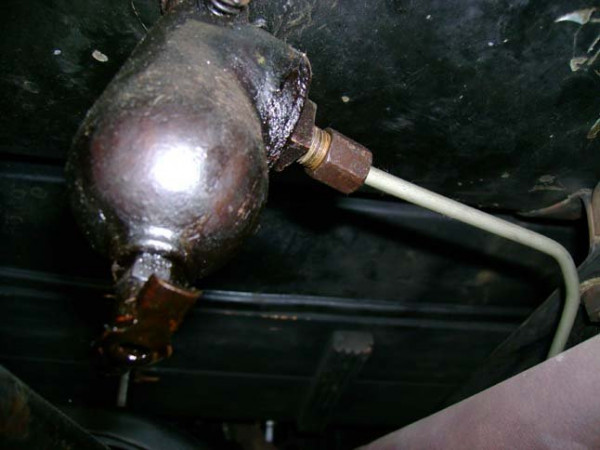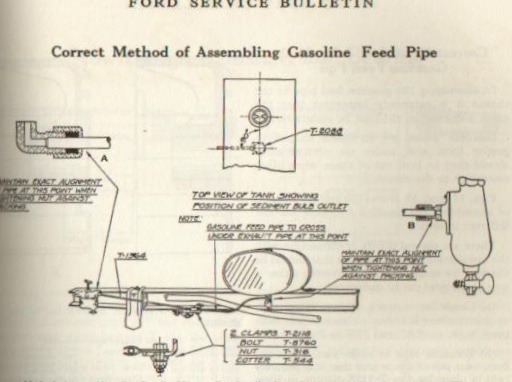Page 1 of 1
Replacement of Fuel Line
Posted: Wed Oct 14, 2020 9:55 pm
by TrashMan
I want to start off by saying how honored I am to finally be a part of this amazing hobby. I brought home my newly acquired 1925 Tudor Sedan last Friday. I’m really eager to learn as much as I can about the maintenance and upkeep,Newbie here, so please bare with me. After looking it over, I found some pretty disturbing things, one being the previous owner replaced the steel fuel line with copper. I want to change it back. Question is how long was the original line? can I use 1/4 inch steel brake line as a fuel line?
Re: Replacement of Fuel Line
Posted: Wed Oct 14, 2020 10:53 pm
by Steve Jelf
Yes, steel brake line is good.
The line attaches with a #2910 pack nut at each end and a #6154 elbow at the carburetor.
You can use bits of ¼" hose for gaskets in the pack nuts.
I don't know the length of the line. I just cut it to fit.
Re: Replacement of Fuel Line
Posted: Wed Oct 14, 2020 11:14 pm
by Piewagon
Since there is no fuel pump the fuel is not under any big pressure. For the record there is solid proof that ALL Ford model T's used BRASS tubing for fuel line - for all years. Some of the brass tubing was seamed and soldered and that type was pressure tested after being bent to shape. Steel line is OK but main issue is that you need the line to not be hooked to anything other than at each end. Carb on one end and tank sediment bulb on the other end. The rubber hose works better than the original felt packing because it "gives" a little to allow the line to not break from metal fatigue as the engine and tank rock a bit at each end of the fuel line. The Model T is built on wagon technology which allows things to twist and turn as the car goes over hill and glen. To that end DO NOT USE a ferrule around the outer tube and tighten it up at the ends since this gives a perfect place for the fuel line to snap off at the ferrule at either end that has one. Hope this helps and do ask questions. Generally my experience has been the more original the car is the more reliable it is. There is not a car on the planet that has been more "debugged" than the 15 million Model T's. Every problem they had is by now well known and documented - somewhere. If you ever get a second model T - NEVER park them side by side or you will then have 6 or more T's around very soon. They seem to mate up. Welcome to the best hobby in the world.
Re: Replacement of Fuel Line
Posted: Thu Oct 15, 2020 1:04 am
by TrashMan
I sure appreciate the replies, thanks! It truly is a great hobby! On the subject of using the 1/4 inch hose bits, how long should I cut them?
Re: Replacement of Fuel Line
Posted: Thu Oct 15, 2020 1:30 am
by Allan
I cut 3/8" pieces, and then cut and peel off the outer layer. Most fuel hose is too thick to go inside the packnut. The inner layer is plenty to give a good seal.
Allan from down under
Re: Replacement of Fuel Line
Posted: Thu Oct 15, 2020 10:54 am
by Original Smith
I agree with John. However, I have a copper line on one of my cars that I put on it when I was a teenager, and it has ferrules too! It is still on the car with over 57,000 miles. I know better now, and use brass tubing with the original felt packing at each end. I haven't used steel brake tubing yet, but I don't see why it wouldn't work well, and would look the same as the zinc plated original brass line.
Re: Replacement of Fuel Line
Posted: Thu Oct 15, 2020 11:16 am
by Norman Kling
Where is the tank on your tudor? If under the seat, how do you get into the back seat? Two important things about the fuel line are that the line goes up toward the sediment bulb and toward the carburetor. The lowest point is somewhere between the two, but it should be routed down to the lowest point and up toward the ends. This is to prevent getting an air bubble trapped between the two ends, because the fuel will rise above air. The other thing is not to have the line running next to the exhaust pipe. It can cross the pipe at right angles but either under or over the pipe as far as you can get it without risking getting caught on something as you drive along. It is OK to use a P shaped clamp to attach it to the frame. The reason to keep it away from the exhaust pipe is to prevent vapor lock where the fuel evaporates and forms a gas bubble and will not flow to the carburetor. I will attach pictures of the fuel line as I have attached it on my 22 Roadster which has the tank under the front seat. I have run it from the sediment bulb directly to the top frame rail over the exhaust pipe, then along the frame gradually sloping downward to the clamp on the lower frame rail next to the brake cross shaft. Then upward toward the upper frame rail and through the notch in the wood block at the crankshaft ear and to the carburetor. I have had no problems with it.

[/attachment]
Re: Replacement of Fuel Line
Posted: Thu Oct 15, 2020 12:14 pm
by DanTreace
Template for forming the steel line. Easy to bend with hands, just take some wide bends.
Drew template on workbench and formed the line to match.
Re: Replacement of Fuel Line
Posted: Thu Oct 15, 2020 12:23 pm
by TrashMan
Thanks Dan, that diagram really helps! My tank is also located under the drivers seat.
Re: Replacement of Fuel Line
Posted: Fri Oct 16, 2020 4:51 am
by Alan Long
I use 5/16” Copper Tubing with the Ferrules / shut off valve screwed directly into the carby and agree their may well be an issue with the ferrules but to date all good.
I chose to increase from 1/4” to 5/16” but as their are diameter restrictions in the carby didn’t go to 3/8”
Never had surging or any fuel supply issues to the engine. I also have the exhaust pipe insulated in the general area.
Alan in Western Australia
Re: Replacement of Fuel Line
Posted: Fri Oct 16, 2020 11:13 am
by RGould1910
Where I live its very hard to find stiff copper tubing like what ws available 15 years ago. Its all the soft stuff that easily collapses under pressure. Lately I've used the steel or brass tubing from Langs. I run an inline filter with rubber gas line connectors and a compression ring at the segiment bulb. The rubber connectors at the filter take the vibration allowing me to use the compression ring.
Re: Replacement of Fuel Line
Posted: Fri Oct 16, 2020 8:12 pm
by Allan
Richard you are fortunate that the compression ring seals for you. While the packnut is machined, the fitting in the outlet is not. It is as cast. The packnut machining is also not machined at an angle truly compatible with the compression rings. The same goes at the carburettor end. The elbow is a casting and the end is not machined. For the compression ring to work as intended, both the nut and the receiver should be machined on a taper to allow the ring to be compressed and the two surfaces to seal on the fittings.
Allan from down under.
Re: Replacement of Fuel Line
Posted: Sat Oct 17, 2020 8:21 am
by henryford2
Re: Replacement of Fuel Line
Posted: Sat Oct 17, 2020 10:02 am
by Original Smith
Dan: It would be great if you could supply a copy of your template above to us lazy guys to use? I've made several gas lines over the years, just eyeballing it. They have all worked well. Lately, I've used the felt packing, as original, with no problems whatsoever. I look at some of the photos above and wonder why people go to so much trouble to do stuff incorrectly!
Re: Replacement of Fuel Line
Posted: Sat Oct 17, 2020 10:33 am
by DanTreace
Larry
That gas line sketch is on the instructions that come from Lang's, if you order their steel gas line.
So compliments go to LANG'S for doing that sketch. Have found it works great and makes easy method to follow, and always works swell.

- Scan0242.JPG (80.09 KiB) Viewed 4658 times
Compliments of Lang's: The finished line ends up fine when done, (leave a bit extra at each straight end for trimming, as a bit needs to slip up into the fuel outlet fitting of the carb and same at the sediment bulb.)
Re: Replacement of Fuel Line
Posted: Sat Oct 17, 2020 11:14 am
by Shane Lach
I just replaced my fuel line recently with 1/4" ni-copp. It's great to work with. Nice and flexible. I used vendor supplied rubber ferrules and nuts. The ni-copp line I used had a larger inside diameter than the copper line which was on the car previously, despite both being 1/4". That was nice to find I increased fuel flow to the carb.
Re: Replacement of Fuel Line
Posted: Sat Oct 17, 2020 6:14 pm
by Allan
While the Lang's template is helpful, it if not the whole answer. A standard template demands a set of standard specs. That presumes that every fuel outlet at the tank has exactly the same orientation. Clearly, with the history of our cars that is not going to happen. The tapered thread on the outlet will tighten where it needs to. I would suggest buying a little more tubing than necessary and following an approximate route as near as possible to standard. This may mean considerable variations at the tank end of the line.
Sometimes the brass casting in the tank and the thread on the outlet tighten up with the fuel line outlet way out of whack. I am averse to screwing things overtight and breaking the solder joint between the tank and brass casting, just as I am to relying on sealants at the thread and leaving the outlet at less than optimal tension. I have resorted to tinning the thread on the outlet and wire brushing that tinning off while hot, so that the thread is built up somewhat and comes up to tension somewhat earlier than before, allowing a more favourable orientation of the outlet.
Hope this helps,
Allan from down under.